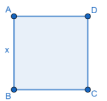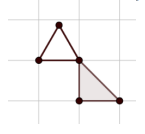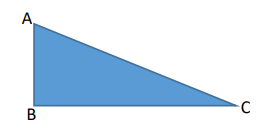Solve mathematical and real-world problems involving right triangles using trigonometric ratios and the Pythagorean Theorem.
: Instruction includes procedural fluency with the relationships of side lengths in special right triangles having angle measures of 30°-60°-90° and 45°-45°-90°.
| Course Number1111 |
Course Title222 |
| 1200400: | Foundational Skills in Mathematics 9-12 (Specifically in versions: 2014 - 2015, 2015 - 2022, 2022 - 2024, 2024 and beyond (current)) |
| 1206310: | Geometry (Specifically in versions: 2014 - 2015, 2015 - 2022, 2022 - 2024, 2024 and beyond (current)) |
| 1206320: | Geometry Honors (Specifically in versions: 2014 - 2015, 2015 - 2022, 2022 - 2024, 2024 and beyond (current)) |
| 7912070: | Access Mathematics for Liberal Arts (Specifically in versions: 2014 - 2015, 2015 - 2018, 2018 - 2019, 2019 - 2022, 2022 - 2023, 2023 and beyond (current)) |
| 1206315: | Geometry for Credit Recovery (Specifically in versions: 2014 - 2015, 2015 - 2022, 2022 - 2024, 2024 and beyond (current)) |
| 7912065: | Access Geometry (Specifically in versions: 2015 - 2022, 2022 and beyond (current)) |
| 1207350: | Mathematics for College Liberal Arts (Specifically in versions: 2022 - 2024, 2024 and beyond (current)) |
| Name |
Description |
| Sine and Cosine | Students are asked to explain the relationship between sine and cosine of the acute angles of a right triangle. |
| Patterns in the 30-60-90 Table | Students are asked to use 30-60-90 triangle relationships to observe and explain the relationship between sin 30 and cos 60 (or sin 60 and cos 30). |
| Pyramid Height | Students are asked to determine the length of a side of a right triangle in a real-world problem. |
| Washington Monument | Students are asked to find the angle of elevation in a real world situation modeled by a right triangle. |
| Step Up | Students are asked to explain the relationship among angles in a diagram involving a right triangle and to find one angle of the right triangle. |
| River Width | Students are asked to find an unknown length in a real world context requiring right triangle trigonometry. |
| Perilous Plunge | Students are asked to find an unknown length in a real world context requiring right triangle trigonometry. |
| Holiday Lights | Students are asked to solve a problem in a real world context requiring the use of the Pythagorean Theorem. |
| Will It Fit? | Students are asked to solve a problem in a real world context using the Pythagorean Theorem. |
| TV Size | Students are asked to solve a problem in a real world context requiring the use of the Pythagorean Theorem. |
| Name |
Description |
| Estimating Resources | Using the case study, "Catapult Catastrophe," students will explore the meaning and importance of managing a project’s scope, construction, and cost. Students will be split into groups to brainstorm and create a materials list for the construction of a catapult for a physics project. Groups will then use the materials list to determine a budget for the project. Each group will submit a list of materials required for the project and a budget based on the price of the materials. |
| Deriving and Applying the Law of Sines | Students will be introduced to a derivation of the Law of Sines and apply the Law of Sines to solve triangles. |
| The Seven Circles Water Fountain | Students will apply concepts related to circles, angles, area, and circumference to a design situation. |
| Sine and Cosine Relationship between Complementary Angles | This is a lesson on the relationship between the Sine and Cosine values of Complementary Angles. |
| Will You Survive? | Students are stranded on a desert island and will need to use the law of sines in order to find the quickest path to a rescue vessel.
Note: This is not an introductory lesson for the standard. |
| The Copernicus' Travel | This lesson uses Inverse Trigonometric Ratios to find acute angle measures in right triangles. Students will analyze the given information and determine the best method to use when solving right triangles. The choices reviewed are Trigonometric Ratios, The Pythagorean Theorem, and Special Right Triangles. |
| The Trig Song | This lesson is a group project activity designed to reinforce the concepts of sine and cosine. The lesson begins with a spiral review of the concepts, which will move into the group project - writing an original song to demonstrate understanding and application of sine and cosine ratios. |
| How Tall am I? | Students will determine the height of tall objects using three different calculation methods. They will work in groups to gather their data and perform calculations. A whole-class discussion is conducted at the end to compare results and discuss some of the possible errors. |
| Wrapping Up Geometry (Surface Area of Triangular Prisms) | This lesson is designed to take students from recognizing nets of triangular prisms and finding areas of their individual faces, to finding the surface area of triangular prisms. |
| Just Plane Ol' Area! | Students will construct various figures on coordinate planes and calculate the perimeter and area. Use of the Pythagorean theorem will be required. |
| Survey Says... We're Using TRIG! | This lesson is meant as a review after being taught basic trigonometric functions. It will allow students to see and solve problems from a real-world setting. The Perspectives video presents math being used in the real-world as a multimedia enhancement to this lesson. Students will find this review lesson interesting and fun. |
| Name |
Description |
| Coins in a circular pattern | Using a chart of diameters of different denominations of coins, students are asked to figure out how many coins fit around a central coin. (For this task, United States coins are used, but the task can be adapted for coins from other countries.) |
| Finding the area of an equilateral triangle | This problem solving task asks students to find the area of an equilateral triangle. Various solutions are presented that include the Pythagoren theorem and trigonometric functions. |
| The Lighthouse Problem | This problem asks students to model phenomena on the surface of the earth by examining the visibility of the lamp in a lighthouse from a boat. |
| Mt. Whitney to Death Valley | This task engages students in an open-ended modeling task that uses similarity of right triangles. |
| Seven Circles III | This provides an opportunity to model a concrete situation with mathematics. Once a representative picture of the situation described in the problem is drawn (the teacher may provide guidance here as necessary), the solution of the task requires an understanding of the definition of the sine function. |
| Eratosthenes and the circumference of the earth | This problem solving task gives an interesting context for implementing ideas from geometry and trigonometry. |
| Neglecting the Curvature of the Earth | This task applies geometric concepts, namely properties of tangents to circles and of right triangles, in a modeling situation. The key geometric point in this task is to recognize that the line of sight from the mountain top towards the horizon is tangent to the earth. We can then use a right triangle where one leg is tangent to a circle and the other leg is the radius of the circle to investigate this situation. |
| As the Wheel Turns | In this task, students use trigonometric functions to model the movement of a point around a wheel and, through space. Students also interpret features of graphs in terms of the given real-world context. |
| Name |
Description |
| Coins in a circular pattern: | Using a chart of diameters of different denominations of coins, students are asked to figure out how many coins fit around a central coin. (For this task, United States coins are used, but the task can be adapted for coins from other countries.) |
| Finding the area of an equilateral triangle: | This problem solving task asks students to find the area of an equilateral triangle. Various solutions are presented that include the Pythagoren theorem and trigonometric functions. |
| The Lighthouse Problem: | This problem asks students to model phenomena on the surface of the earth by examining the visibility of the lamp in a lighthouse from a boat. |
| Mt. Whitney to Death Valley: | This task engages students in an open-ended modeling task that uses similarity of right triangles. |
| Eratosthenes and the circumference of the earth: | This problem solving task gives an interesting context for implementing ideas from geometry and trigonometry. |
| Neglecting the Curvature of the Earth: | This task applies geometric concepts, namely properties of tangents to circles and of right triangles, in a modeling situation. The key geometric point in this task is to recognize that the line of sight from the mountain top towards the horizon is tangent to the earth. We can then use a right triangle where one leg is tangent to a circle and the other leg is the radius of the circle to investigate this situation. |
| As the Wheel Turns: | In this task, students use trigonometric functions to model the movement of a point around a wheel and, through space. Students also interpret features of graphs in terms of the given real-world context. |
| Name |
Description |
| Coins in a circular pattern: | Using a chart of diameters of different denominations of coins, students are asked to figure out how many coins fit around a central coin. (For this task, United States coins are used, but the task can be adapted for coins from other countries.) |
| Finding the area of an equilateral triangle: | This problem solving task asks students to find the area of an equilateral triangle. Various solutions are presented that include the Pythagoren theorem and trigonometric functions. |
| The Lighthouse Problem: | This problem asks students to model phenomena on the surface of the earth by examining the visibility of the lamp in a lighthouse from a boat. |
| Mt. Whitney to Death Valley: | This task engages students in an open-ended modeling task that uses similarity of right triangles. |
| Eratosthenes and the circumference of the earth: | This problem solving task gives an interesting context for implementing ideas from geometry and trigonometry. |
| Neglecting the Curvature of the Earth: | This task applies geometric concepts, namely properties of tangents to circles and of right triangles, in a modeling situation. The key geometric point in this task is to recognize that the line of sight from the mountain top towards the horizon is tangent to the earth. We can then use a right triangle where one leg is tangent to a circle and the other leg is the radius of the circle to investigate this situation. |
| As the Wheel Turns: | In this task, students use trigonometric functions to model the movement of a point around a wheel and, through space. Students also interpret features of graphs in terms of the given real-world context. |



